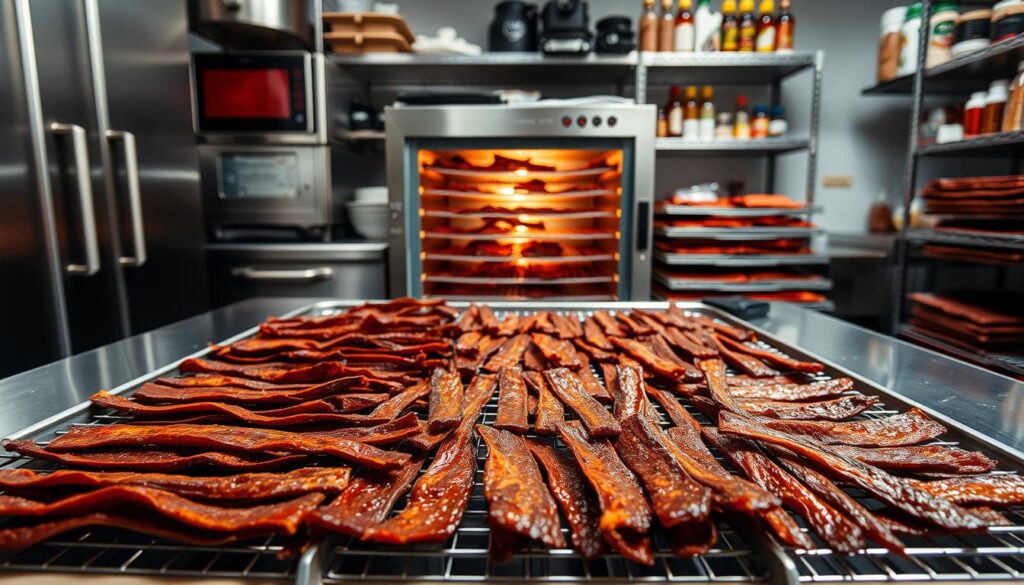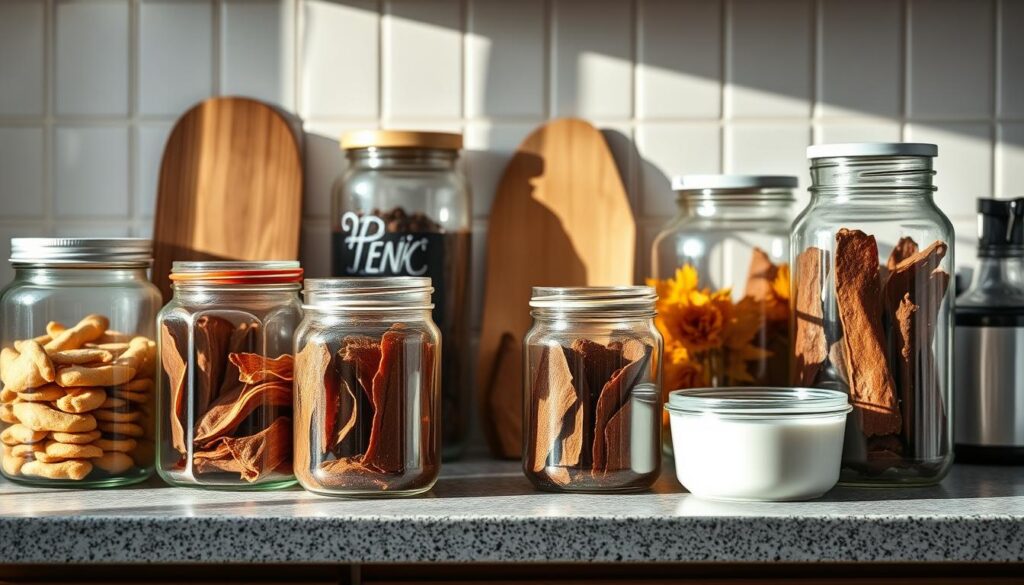Ever tried dehydrating jerky twice? Many home cooks wonder if reprocessing underdone meat is safe or effective. The question “can you dehydrate jerky twice” sparks debate among food preservation enthusiasts. This article answers whether multiple dehydration cycles improve texture, extend shelf life, or pose hidden risks.
Dehydrating jerky removes moisture to prevent spoilage, but redoing the process raises concerns about safety and quality. Learn how repeated drying affects flavor, texture, and bacteria growth. Discover USDA guidelines and practical steps to avoid mistakes.

Key Takeaways
- Redrying jerky may extend shelf life but increases bacterial risks if not done right.
- USDA warns against unsafe temperature zones during multiple dehydration cycles.
- Texture and flavor changes are inevitable after second dehydration.
- Alternative methods exist to fix underprocessed jerky without risking safety.
- Proper packaging is vital after double dehydration to maintain freshness.
Understanding the Jerky Dehydration Process
The jerky making process turns raw meat into a snack that lasts. It does this by removing moisture, which stops bacteria from growing. This is a key part of keeping food safe.
How Dehydration Preserves Meat
Dehydrating jerky lowers its moisture to less than 30%. This makes it hard for microbes to grow. Long ago, people dried meat in the sun and wind. Today, we use faster methods that are just as safe.
The Science Behind Water Activity in Jerky
Water activity (Aw) shows how much moisture is left for bacteria. For jerky to be safe, Aw must be 0.85 or lower. This keeps it safe without drying it too much. The type of meat and seasonings can change how much moisture is left.
Traditional vs. Modern Jerky Making Methods
- Traditional: Sun drying or air drying needs low humidity. It’s free but takes a lot of time and depends on the weather.
- Modern: Electric dehydrators or ovens control temperature (130–160°F). They are faster and consistent but use energy and cost more upfront.
Which method you choose depends on what you want. Both aim to make jerky that’s safe, tasty, and has the right texture.
Why You Might Consider Dehydrating Jerky Again
Ever thought about drying meat twice when making jerky? Here’s what you need to know before you decide.
Addressing Underprocessed Jerky
Does your jerky feel soggy or slimy? That’s a sign it wasn’t dried enough. Double dehydrating jerky can fix this. Look for spots that are soft to the touch. These areas can grow bacteria if not dried right.
- Feel for dampness between layers
- Smell for off-odors
- Check for visible moisture beads
Extending Shelf Life
Lower moisture means longer shelf life. A second drying cycle can make the jerky safe to store. Here’s how moisture affects how long it lasts:
| Moisture Level (%) | Shelf Life |
|---|---|
| Below 15% | Up to 2 months at room temp |
| 16-20% | 1-2 weeks unrefrigerated |
| 21-25% | Risk of mold within days |
Texture Preferences and Adjustments
Do you like your jerky crispy or chewy? A second drying can help. Try different times and temperatures to get the texture you want:
- Set dehydrator to 160°F for 2 hours for extra dryness
- Use 145°F for 4 hours for a chewy result
Keep an eye on it to avoid drying it too much and losing flavor.
Can You Dehydrate Jerky Twice? The Straight Answer
Yes, you can dehydrate jerky twice, but it depends on certain conditions. You must follow proper jerky preservation techniques to avoid risks. If the first dehydration didn’t get the moisture right, a second try might work—if done right.
- Storage matters: Keep jerky refrigerated or frozen between sessions to stop bacterial growth.
- Time limits: Do it within 24 hours of the first dehydration to avoid spoilage.
- Initial quality: Only try this with jerky that’s underdone, not spoiled or discolored.
Re-dehydrating doesn’t ensure safety. It can dry out the flavor and texture. Always check the temperature (160°F for ground meats, 145°F for cuts) to meet USDA standards. If unsure, throw out questionable batches—safety is the top priority. Proper jerky preservation techniques help the second dehydration succeed without harm.
For the best results, use a hygrometer to track moisture content. Focus on keeping it fresh and follow guidelines to maintain quality. Never think a second cycle fixes a bad first attempt—pay attention to storage and timing.
The Safety Concerns of Multiple Dehydration Cycles
Keeping safety in mind is key when you re-dehydrate jerky. Doing it multiple times ups the risk of contamination. It’s important to control moisture and temperature well to prevent harmful bacteria.
Bacterial Growth Risks During Rehydration
Rehydrating meat can let it soak up moisture from the air. This creates a perfect spot for bacteria to grow. Bacteria like Salmonella, E. coli, and Listeria thrive in damp places. Make sure to dry the meat well between cycles to stop bacteria.
Temperature Danger Zones to Avoid
Don’t let jerky sit between 40°F and 140°F. This is when bacteria grow the fastest. Here’s how to stay safe:
- Dry at 160°F or higher to kill pathogens
- Avoid leaving meat at room temperature for more than 2 hours
- Use a food thermometer to monitor progress
USDA Guidelines for Jerky Processing
The USDA has strict rules to keep food safe. Here are the main ones:
- Heat meat to 160°F before dehydrating jerky
- Maintain water activity (aw) levels below 0.85
- Avoid raw or partially dried meat storage beyond 2 hours
Ignoring these rules can lead to serious food poisoning.
How to Properly Rehydrate Jerky Before Second Dehydration
Rehydrating jerky safely means following specific steps. This ensures moisture is added without risking spoilage. Here’s how to prepare meat for a second dehydration cycle while keeping it safe.
- Broth method: Submerge jerky slices in warm broth for 10–15 minutes until slightly softened.
- Cold water soak: Place in a bowl of cold water for 5–10 minutes, flipping occasionally.
- Marinade method: Soak in fresh marinade for 20–30 minutes to restore moisture and enhance flavor.
- Steam method: Use a steamer basket over simmering water for 3–5 minutes for gentle rehydration.
After choosing your method, pat the meat dry with clean towels. Make sure the jerky is pliable but not too soggy before reloading the dehydrator. Over-soaking can lead to bacterial growth, so never leave it unrefrigerated for longer than 2 hours.
Check the texture closely: Flex a piece gently; it should bend without cracking. Adjust seasoning if using marinades, as rehydrating can intensify flavors. Always refrigerate rehydrated jerky immediately if not dehydrating within 30 minutes.
This part of the jerky making process is key to the final result. Test small batches first to balance taste and texture changes caused by rehydration mediums. Always follow food safety guidelines by adhering to time limits and proper storage during this critical step.
Best Practices for Double Dehydrating Jerky
Learning best practices for jerky dehydration helps keep your second drying cycle safe and tasty. Here are the steps to get the best results with double dehydrating jerky:

Temperature Settings for Second Dehydration
Change temperatures based on your gear:
- Electric dehydrators: Use 160°F (71°C) to finish drying without drying out flavor.
- Ovens: Set to 200°F (93°C) with a tray for even airflow.
Timing Considerations
Timing depends on how dry your jerky was first:
- Check flexibility: Jerky should bend but not stick together.
- Test with samples: Cut small pieces to assess moisture levels.
- Monitor every 30 minutes after the first 2 hours.
Monitoring Moisture Content
Test moisture with these methods:
- Feel: Dry, leathery texture means readiness.
- Moisture meter:
Always make sure there’s good airflow and don’t over-dry. These steps will help your double dehydrated jerky stay safe and delicious.
Impact on Flavor and Texture After Second Dehydration
Double dehydrating jerky changes its flavors and texture. Knowing these changes helps you get better results. It’s about how flavors get stronger or weaker and how the texture changes.
Expected Taste Changes
Double dehydrating can make flavors more intense. Smoky or salty tastes might get stronger. But, delicate herbs like parsley could lose their flavor.
To keep the flavor, use strong spices like garlic or black pepper in the second cycle. Don’t over-marinate, as too much moisture can dry unevenly.
Texture Transformation
Meat can get tougher with repeated drying. Too much drying takes away moisture, making it less chewy. Watch the second cycle closely.
Try to dry for 10–12 hours at 160°F (71°C). Thin cuts stay chewier than thick ones.
Seasoning Adjustments to Consider
- Boost umami: Add soy sauce or worcestershire before redehydration for depth.
- Acidic balance: Citrus or vinegar in marinades brighten flavors lost during drying.
- Oil retention: Use oil-based rubs to lock in moisture and prevent dryness.
Start with small batches to find the right balance. Adjust seasoning little by little based on your first batch’s outcome.
Alternative Methods to Fix Underprocessed Jerky
If re-dehydrating isn’t ideal, explore these jerky preservation techniques to salvage your batch without a full second dehydration cycle:
| Method | Process | Benefits | Limitations |
|---|---|---|---|
| Oven Reheating | Spread slices on a baking sheet at 160–170°F for 30–60 minutes. | Quickly dries surface moisture without extended processing. | May crisp edges unevenly. |
| Microwave Finishing | Place in microwave-safe dish, cover with paper towels, and heat in 30-second bursts. | Fast and convenient for small batches. | Risk of over-drying or uneven results. |
| Vacuum Sealing | Seal with oxygen absorbers in a FoodSaver or similar device. | Extends shelf life by removing air exposure. | Requires vacuum equipment. |
| Refrigeration | Store in an airtight container in the fridge for 1–2 days. | Slows bacterial growth temporarily. | Shorter shelf life compared to dehydrating jerky fully. |
| Cooking Use | Chop into stir-fries, soups, or casseroles. | Repurposes partially dried meat safely. | Not ideal for eating as standalone jerky. |
Always prioritize safety: never consume visibly moldy or off-smelling meat. Pair these fixes with proper sanitation practices. Choose the method that best matches your time, tools, and desired outcome.
Storage Tips After Double Dehydrating Jerky
Storing your twice-dehydrated jerky right keeps it fresh and tasty. Use these jerky storage tips and jerky preservation techniques to keep it good for longer.

Choose Packaging That Keeps Moisture Out
Find the best container to keep air and moisture away:
| Packaging | Pros | Best Use |
|---|---|---|
| Vacuum Sealed Bags | Removes oxygen, extends shelf life | Long-term storage |
| Mylar Bags + Oxygen Absorbers | Blocks light, oxygen, and moisture | Home pantry storage |
| Food-Safe Glass Jars | Transparent for visibility, airtight | Short-term storage |
| Plastic Containers | Convenient, reusable | Use with desiccant packets |
Store in a Cool, Dry Place
- Temperature: 40°F or colder
- Humidity: Below 50% to prevent mold
- Avoid direct light exposure
- Ensure airflow around containers
How Long Will It Last?
Shelf life varies based on your choices:
| Method | Shelf Life |
|---|---|
| Vacuum sealed + freezer | 6–12 months |
| Mylar + oxygen absorbers | 4–6 months |
| Airtight containers | 1–3 months |
Always check for off smells or mold before eating.
Common Mistakes When Dehydrating Jerky Multiple Times
Mastering best practices for jerky dehydration is key to avoiding common errors during repeated drying. Here’s what to watch for:
- Skipping pre-drying reheating: Failing to heat meat to 165°F before reprocessing can leave harmful bacteria. Always use a food thermometer.
- Ignoring storage between cycles: Leaving jerky out too long between steps lets moisture seep back in. Refrigerate slices between sessions.
- Uneven slicing: Thick/thin cuts cause uneven drying. Cut meat uniformly at ¼-inch thickness.
- Over-drying: Extending drying time past 8-12 hours turns jerky brittle. Set timers and check texture hourly.
- Ignoring documentation: Jot down time/temperature logs to track progress. Write down each step’s duration.
- Contaminated surfaces: Use fresh utensils and sanitized trays between batches. Cross-contamination risks multiply with each step.
- Skipping seasoning adjustments: Over-salting after rehydration ruins flavor balance. Taste test small batches before full seasoning.
Following these dehydrating jerky guidelines ensures safe, consistent results. Prioritize safety steps like reheating and sanitation to protect both quality and health.
Equipment Recommendations for Optimal Jerky Dehydration
Choosing the right tools is essential for making great jerky. Whether you’re drying meat for the first time or doing it again, the right equipment is key. It ensures your jerky is safe and tastes amazing. Here’s how to pick the best tools for your needs.
Types of Dehydrators for Jerky
- Vertical airflow models: These have trays stacked vertically for even drying. They’re perfect for small batches but might take longer.
- Horizontal airflow systems: These dry meat faster with air moving sideways. They’re great for big batches but need more space.
- Commercial-grade units: These have precise controls and can handle lots of meat. They’re best for those who make jerky often or do double dehydration cycles.
Temperature Control Features to Look For
For best practices for jerky dehydration, look for these features:
- Adjustable thermostats to set 140-160°F ranges for safe pathogen control.
- Digital displays for real-time monitoring of internal temps.
- Automatic shut-off features to prevent overheating during long cycles.
Alternative Equipment Options
If you don’t have a dedicated dehydrator, try these alternatives:
- Convection ovens: Use fan-forced heat for even drying. Set at 160°F and prop the door open slightly.
- Smokers: Add smoky flavor during first dehydration, then use oven for second cycle.
- Air fryers: Work well for small batches. Rotate trays every 30 minutes during second dehydration.
- DIY setups: Use a standard oven with a rack and fan for airflow. Monitor moisture levels closely.
Conclusion
Yes, you can dehydrate jerky twice, but do it carefully. It’s important to rehydrate the jerky first to avoid bacterial growth. Always heat treat the meat to 160°F to kill harmful bacteria.
Skipping steps like checking moisture levels can lead to spoilage. This is unsafe for your food.
Reprocessing can make jerky last longer or change its texture. But, it might also change the flavor and crispness. To keep your jerky safe, use a good dehydrator, watch the drying time, and store it in airtight containers.
By being careful and skilled, you can make jerky twice to your liking. This way, you can enjoy your favorite snack without worrying about safety.
FAQ
Can you dehydrate jerky twice?
Yes, you can dehydrate jerky twice. But, think about storage conditions and time between drying. This ensures safety and quality.
What are the best practices for jerky dehydration?
Cut meat evenly and use the right temperature settings. Check moisture and store jerky well. This keeps flavor and prevents bacteria.
What are common signs of underprocessed jerky?
Look for chewy texture, sticky surface, or strong smell. Fixing underprocessing is key to avoid illness.
How can you safely rehydrate jerky before the second dehydration?
Rehydrate jerky in broth, water, or marinade. This adds moisture back. But, refrigerate and check timing to stop bacteria.
What storage tips should I follow after double dehydrating jerky?
Use airtight containers, like vacuum-sealed bags or mylar bags. Store in a cool, dark, dry place for longer shelf life.
How does dehydration impact jerky flavor and texture?
Second dehydration can make flavors stronger but may make it tougher. Adjust seasonings before the second drying for better taste.
What safety concerns should I consider with multiple dehydration cycles?
Be careful of bacterial growth during rehydration. Make sure to avoid the temperature danger zone (40°F-140°F) during the second dehydration.
What equipment is recommended for optimal jerky dehydration?
Use a dehydrator with adjustable temperature or an oven with reliable controls. Commercial-grade dehydrators give the best results.
